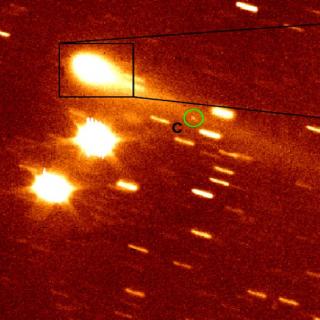Bibcode
Peña-Asensio, Eloy; Visuri, Jaakko; Trigo-Rodríguez, Josep M.; Socas-Navarro, Hector; Gritsevich, Maria; Siljama, Markku; Rimola, Albert
Bibliographical reference
Icarus
Advertised on:
1
2024
Journal
Citations
13
Refereed citations
10
Description
The observation of interstellar objects 1I/'Oumuamua and 2I/Borisov suggests the existence of a larger population of smaller projectiles that impact our planet with unbound orbits. We analyze an asteroidal grazing meteor (FH1) recorded by the Finnish Fireball Network on October 23, 2022. FH1 displayed a likely hyperbolic orbit lying on the ecliptic plane with an estimated velocity excess of ∼0.7 km s-1 at impact. FH1 may either be an interstellar object, indicating a high-strength bias in this population, or an Oort cloud object, which would reinforce migration-based solar system models. Furthermore, under the calculated uncertainties, FH1 could potentially be associated with the passage of Scholz's binary star system. Statistical evaluation of uncertainties in the CNEOS database and study of its hyperbolic fireballs reveals an anisotropic geocentric radiant distribution and low orbital inclinations, challenging the assumption of a randomly incoming interstellar population. Orbital integrations suggest that the event on March 9, 2017 (IM2) from CNEOS may have experienced gravitational perturbation during the Scholz fly-by, contingent upon velocity overestimation within the expected range. These findings suggest that apparent interstellar meteors may, in fact, be the result of accelerated meteoroid impacts caused by close encounters with massive objects within or passing through our solar system.
Related projects

Small Bodies of the Solar System
This project studies the physical and compositional properties of the so-called minor bodies of the Solar System, that includes asteroids, icy objects, and comets. Of special interest are the trans-neptunian objects (TNOs), including those considered the most distant objects detected so far (Extreme-TNOs or ETNOs); the comets and the comet-asteroid
Julia de
León Cruz